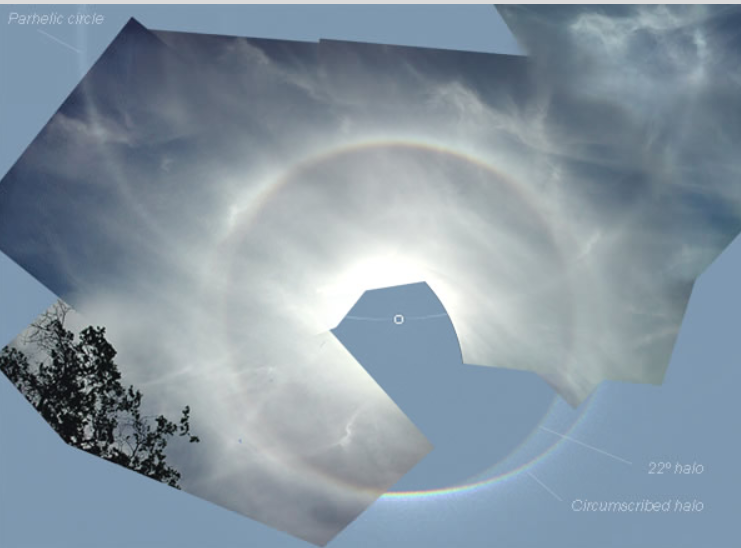Circumscribed Halo
The Circumscribed Halo: A Colorful Phenomenon in the Sky
Have you ever noticed a brightly colored oval around the sun, tangential to the inner 22º halo? If so, you have witnessed the captivating atmospheric optics phenomenon known as the circumscribed halo. This remarkable halo appears as a vibrant ring of colors encircling the sun, with its brightness being most pronounced above and below the sun. In some instances, the only indication of its presence is localized brightenings of the 22º halo. The shape of the circumscribed halo is heavily influenced by the altitude of the sun, resulting in intriguing variations. Let's delve deeper into this fascinating optical phenomenon and explore its characteristics.
The Relationship with the 22º Halo
The circumscribed halo and the inner 22º halo are closely connected. In fact, the circumscribed halo is tangential to the inner halo directly above and below the sun. This means that they share common tangents, creating an optical overlap. The circumscribed halo is brightest precisely at these points of tangency, enhancing its visual prominence. Interestingly, sometimes the only discernible sign of the circumscribed halo is localized brightenings within the 22º halo, adding an element of surprise to its appearance.
Solar Altitude and Shape Variations
One intriguing aspect of the circumscribed halo is its shape, which is heavily influenced by the altitude of the sun. When the sun is positioned lower than 29º, the circumscribed halo undergoes a transformation, separating into distinct upper and lower tangent arcs. These arcs are formed by the same rays of light and ice crystals that contribute to the formation of the circumscribed halo. This separation creates a visually captivating effect, further enhancing the allure of this atmospheric phenomenon.
Exploring Animation
To better understand the dynamics of the circumscribed halo, it is helpful to view an animation of its formation. Animations provide a visual representation of how the halo evolves as the sun's altitude changes. By observing these animations, one can gain a deeper appreciation for the intricate interplay between sunlight, ice crystals, and atmospheric conditions that give rise to this captivating optical display.
Unveiling the Circumscribed Halo's Origins
The formation of the circumscribed halo is intricately linked to the interaction between sunlight and ice crystals suspended in the atmosphere. As sunlight passes through these hexagonal ice crystals, it undergoes refraction, dispersion, and reflection. This bending and scattering of light result in the characteristic colors seen in the circumscribed halo. The precise mechanisms behind the formation of this halo are still an active area of research, with scientists continuously striving to unravel the complexities of this atmospheric phenomenon.
Real-Life Observations
While scientific explanations provide valuable insights into the circumscribed halo, there is nothing quite like witnessing this spectacle firsthand. Individuals fortunate enough to observe this optical phenomenon have captured its beauty through photography. These captivating images showcase the vibrant colors and unique shape of the circumscribed halo against the backdrop of the sky. Such photographs serve as a testament to the allure and wonder that atmospheric optics can bring to our lives.
Beyond the Circumscribed Halo
The circumscribed halo is just one of many intriguing atmospheric optics phenomena that captivate our imagination. From rainbows and halos to sun dogs and iridescent clouds, the sky offers a plethora of visual delights. Exploring these phenomena not only deepens our understanding of the natural world but also allows us to appreciate the awe-inspiring beauty that surrounds us each day.
The Future of Atmospheric Optics Research
As our understanding of atmospheric optics continues to evolve, so too does our fascination with these captivating phenomena. Researchers are continually pushing the boundaries of knowledge, striving to uncover the intricacies of light interaction with the atmosphere. Through advancements in technology and ongoing scientific inquiry, we can look forward to new insights and discoveries in the field of atmospheric optics, providing us with a deeper understanding of the wonders that unfold above us.
Conclusion
The circumscribed halo is a mesmerizing atmospheric optics phenomenon that manifests as a brightly colored oval encircling the sun. Its relationship with the inner 22º halo, shape variations based on solar altitude, and the interplay between sunlight and ice crystals all contribute to its captivating visual display. By exploring animations, real-life observations, and ongoing research, we gain a deeper appreciation for the intricate beauty of the circumscribed halo and the countless wonders that await us in the realm of atmospheric optics. So, keep your eyes to the sky and prepare to be amazed by the breathtaking displays that nature has in store.

Oval Circumscribed Halo and 22° Halo around a 54° high sun. Montage of photographs taken by Martha Dawson of Squaw Valley, California over a Halosim simulation photos ©2003 Martha Dawson
The circumscribed halo is typically a brightly coloured oval around the sun. It is tangential to the inner 22º halo directly above and below the sun and it is brightest there. Sometimes local brightenings of the 22º halo are the only sign of it. Its shape depends very much on the solar altitude ~ view an animation.
When the sun is lower than 29º the halo separates into the upper and lower tangent arcs. The same rays and crystals form it.
Note: this article has been automatically converted from the old site and may not appear as intended. You can find the original article here.
Reference Atmospheric Optics
If you use any of the definitions, information, or data presented on Atmospheric Optics, please copy the link or reference below to properly credit us as the reference source. Thank you!
-
<a href="https://atoptics.co.uk/blog/circumscribed-halo/">Circumscribed Halo</a>
-
"Circumscribed Halo". Atmospheric Optics. Accessed on December 23, 2024. https://atoptics.co.uk/blog/circumscribed-halo/.
-
"Circumscribed Halo". Atmospheric Optics, https://atoptics.co.uk/blog/circumscribed-halo/. Accessed 23 December, 2024
-
Circumscribed Halo. Atmospheric Optics. Retrieved from https://atoptics.co.uk/blog/circumscribed-halo/.